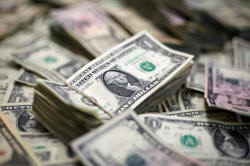Dollar retreats from three-week high as attention shifts
to Fed
 Send a link to a friend
Send a link to a friend
 [March 21, 2018]
By Tommy Wilkes [March 21, 2018]
By Tommy Wilkes
LONDON (Reuters) - The dollar retreated
from three-week highs on Wednesday as traders took some profits before
the Federal Reserve's first expected rate rise of 2018 and focused on
whether it will indicate three or four increases are likely this year.
The dollar <.DXY> fell 0.2 percent against a basket of currencies, after
hitting a nearly three-week high on Tuesday. With the U.S. currency
weakening, the euro and yen were able to recover some losses made on
Tuesday.
The dollar has been stuck in a trading range as investors wait to see
whether the Fed will forecast four rate increases this year, instead of
the median three seen in December's quarterly forecast.
Following the Fed's announcement at 1800 GMT, Jerome Powell will hold
his first news conference as Fed chief at 1830 GMT.

Many analysts doubt the dollar can rally much, since so many investors
remain bearish. The dollar sold off in January and February on bets that
trade and budget deficits would pull it down. Comments by the Treasury
Secretary that a weaker dollar was good for the United States also
weighed on the currency.
The Fed "will have to go some to really move the needle on market
thinking or indeed, to take the dollar out of its current range and the
FX market out of its mindset," said Kit Juckes, chief FX Strategist at
Societe Generale.
The two-year U.S. treasury yield <US2YT=RR> jumped to 2.3449 percent on
Tuesday.
As the U.S. currency fell, the euro <EUR=> - which has been driven by
dollar-related news in recent weeks - gained 0.3 percent to $1.2275,
having fallen 0.78 percent on Tuesday and hitting a near three-week low
of $1.2240.
Adam Cole, chief currencies strategist at RBC Capital Markets, said a
"knee-jerk reaction" to the Fed flagging four hikes this year may see
the dollar strengthen against the euro.
[to top of second column] |

U.S. Dollar banknotes are seen in this photo illustration taken
February 12, 2018. REUTERS/Jose Luis Gonzalez/Illustration

Cole said he remained moderately bullish on the dollar, because the Fed's
raising rates faster than other central banks supported the currency.
Against the yen, the dollar fell 0.2 percent to 106.345 yen <JPY=>, after
Tuesday's gains of 0.4 percent, though trading was slowed by a public holiday in
Tokyo.
MEXICAN PESO, CANADIAN DOLLAR RALLY
Elsewhere, the Canadian dollar and Mexican peso gained after reports that the
U.S. government administration had dropped a demand related to auto exports,
removing a barrier to a deal for a new North American Free Trade Agreement.
The Canadian dollar rose 0.5 percent to C$1.3003 to the U.S. dollar <CAD=D4>,
its best level since March 15. The peso rose more than 1 percent <MXN=D2> to a
one-week high of 18.559 per U.S. dollar.
The Australian dollar fell to a three-month low of $0.7679 <AUD=D4> on Tuesday
but recovered some ground on Wednesday to trade up marginally at $0.7686.
Australia, a big producer of basic commodities, is among the most vulnerable
economies should U.S. protectionism lead to a tit-for-tat reprisal from China, a
key consumer of commodities.
Sterling gained 0.5 percent against the dollar to $1.4065 <GBP=D3> after data
showed U.K. wages grew at their fastest pace for more than two years, supporting
bets that the Bank of England would raise interest rates as early as May.
(Editing by Larry King)
[© 2018 Thomson Reuters. All rights
reserved.] Copyright 2018 Reuters. All rights reserved. This material may not be published,
broadcast, rewritten or redistributed.
Thompson Reuters is solely responsible for this content.
 |